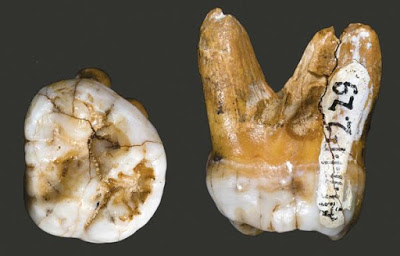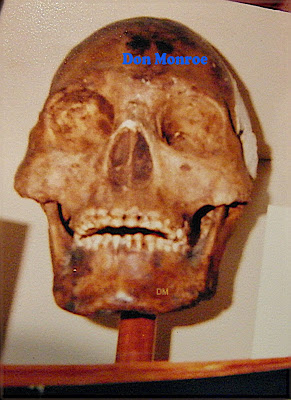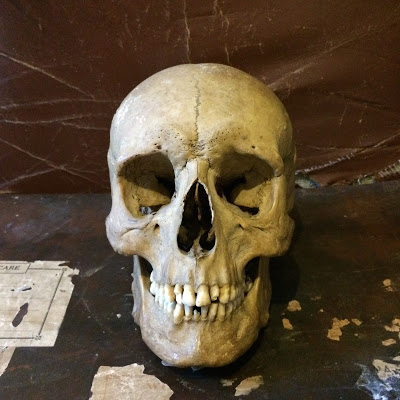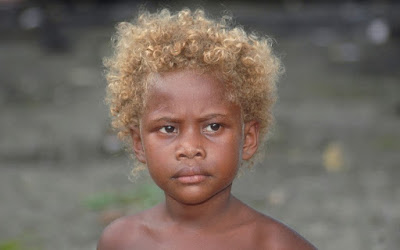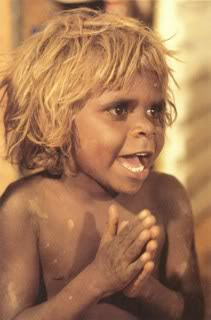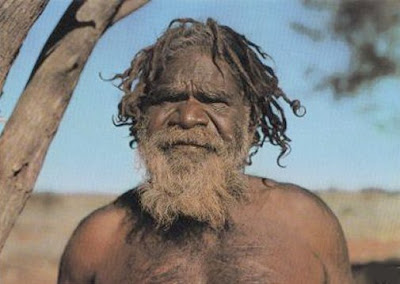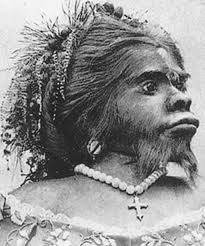

| Online: | |
| Visits: | |
| Stories: |

| Story Views | |
| Now: | |
| Last Hour: | |
| Last 24 Hours: | |
| Total: | |
Newly Released Findings Might Prove Denisovans Were the Ancient Giants!
*A special thanks to Don Monroe, researcher, and MK Davis, researcher and film/video specialist. Don took photos in a museum in Nevada where in the 1970s they had stored some skulls from Lovelock Cave - the infamous site of the battle between Paiute people and the
red-haired giants. He released those photos to MK Davis to present to the world.*
Neanderthal, although he had a somewhat similar skull shape and potential for red hair, was not as big as the reported giants. However, tooth findings from Denisovans (photo at the top of the post) reveal massive molars. When we look at where Denisovan DNA shows up today, we have a seafaring, advanced culture that we could equate with the “giants.”
Skull shapes
In this video (below), MK Davis has made an important realization about the shape of the skulls (pentagonal from behind) and their rocker jaws that correlates with the Polynesian people, showing that they had a similar ancestor.
What we do know about the Polynesian people/aborigines, is that their skull shape has been a way to differentiate their people from Amerindian people of Asian origin. But, repeatedly skulls have been found in America that show tribes with “otamid” head shapes – these very shapes as the one above. (see this university report I wrote about).
What we do know is that aborigines and Melanesian people show a skull shape that is distinctive enough to be able to tell origins differ from the Native American people. So, what is that different influence? The Denisovans.
This giant skull (which appears to have a double row of teeth) was found in Lovelock Cave where there was a supposed showdown with the Paiutes' ancestors and death of the red-haired giants. It might fit a scenario that I have been believing all along – the giants were Denisovans - and another theory that you will find in the last line of this post.…
I've contemplated the double rows of teeth and believe these “giants” were a cousin of ours. We have deciduous baby teeth that we shed for the larger adult teeth. In their case, I believe their kind had more root to the baby teeth – perhaps relating to childhood diet, and the appearance of adult teeth behind them created a double row. When my son was shedding his baby teeth, his adult teeth showed up behind the baby teeth which co-existed for a while until the baby teeth fell out. In this case, it appears they retained those smaller teeth in front….
There is a report of a village in New Mexico way up on the cliffs, 6000 years old, with people with double rows of teeth. The doctor examining them made some notes, “ “Look at those teeth,” said Dr. Cole, tenderly fondling the skull of the giantess. “She has no incisors, no cutting teeth, in front, as have all the other races of which I have any knowledge. She has grinders all around, and so have the other skulls. That shows they were grain-eaters rather than meat-eaters. The foreheads are high and the shape of the skull shows intelligence, but notice how curiously they are flattened at the back.”
Please note in the photo of the Lovelock skull above that there are no incisors!
In this scenario, the Denisovans molars (which were found to be extraordinarily big – see picture at the top of this post), show a very large man with a powerful jaw to handle that.
The very pentagonal shape in the back of the head (see video above) shows that the supporting skull for such a jaw would be shaped with these two points in the back to help anchor the rocking motions of a jaw that the university report (above report link) says was carnivorous. Carnivorous people would be predatory or even cannibalistic, as the Paiutes described them.
Oddly, though, the teeth seem like grinders. It is entirely possible that cannibalism was a show of dominance, power and strength when outnumbered by the native people and being of intimidating size they took advantage of that posture. It is also possible that canine teeth were broken off during the eating of bone marrow and gnawing on bones. I broke off one of my own canines as a child, trying to eat fudge that had completely hardened, and broke off another slamming my mouth shut when I was numbed up from dental work. Life has a way of wearing down our teeth.
What we know is that giants had giant teeth. Denisovans had giant teeth.
At some point, the Denisovans, likely in Siberia or around that region, mated with Homo sapiens tens of thousands of years ago. For the sake of this discussion, let's say 50,000 years ago (we arrived in Europe from Africa around then). Their DNA shows up in Melanesians of the South Pacific, aborigines of Australia and sherpas of Tibet.
This is where time lines get a bit fishy. Experts say we left Africa around 60,000 to 65,000 years ago, but didn't get to Europe until 50,000 years ago, but simultaneously man shows up in Australia at that time.
How did man make such a huge geographical jump when his companions were barely trickling into Europe? Perhaps with assistance!
Those hybrid offspring of Denisovans/Homo sapiens were spreading out around the world quite literally, as they showed up in Australia 50,000 years ago.
The question becomes, did the hybrid offspring join the Denisovans who knew how to make reed boats and traverse waters? Did these offspring settle into the South Pacific lands and the ancestors move on toward the Americas, depositing some of their kind to settle lands and some of the hybrids to help? This would have set up a situation of giants/hybrids living and fighting for resources together in new lands which shows up repeatedly in the native legends.
Homo sapiens, who were certainly not maritime experts fifty thousand years ago, managed to get to lands that needed serious navigation. Their tour guides were likely an advanced people who were used to these obstacles, having been out and about all of Europe and Asian for more than a hundred thousand years before Homo sapiens, also known as the giants.
The Denisovans, spread around the world, perhaps bringing some of their hybrid people with them, going all the way into the Americas around 50,000 years ago.
Their evolution in Eastern Europe occurred ahead of ours because they and Neanderthal were outside of Africa a couple hundred thousand years before us, giving them the chance to travel, adapt to new locations, new challenges, and gaining knowledge before we came out and started to learn the rudimentary skills of a people taking on new lands.
Their skull size alone shows a high level of intelligence and the use the giants had for metallurgy and maritime navigation, canal systems, heiroglyphs, and astronomy were something Homo sapiens had to learn from the example around the world, creating the acquisition of languages that looked similar all over the globe. This would explain many ancient rock drawings and carvings of script that appears to be from other lands, as the origins of all languages were born from the influence of the Denisovans' written language.
The megalithic structures constructed by the giants were much like what we see when Europeans spread out around the world and commenced to build homes by the techniques they knew. Pyramids and other structures showed up around the world in the tens of thousands of years ago, built by the world travelers, the giants.
The giants headed to Easter Island (the long-earreds that were there when the Rapa Nui arrived), on to Peru, up through the Americas, creating civilizations based on waterways and mining. First order for them would have been, seaworthy vehicles, procuring food, digging canals and wells for fresh water, laying down stones structures where they settled, metallurgy for parts, and astronomy to circumnavigate the globe.
In North America, we have found races of natives who had the otamid head shape and tall lean bodies that make them different. Were these, once again, the Denisovans/Homo sapiens hybrids of yet another continent settled by Denisovans when they arrived?Well, these otamid head shapes seem to show up along the coastlines, first landing points. So, tribes such as the Karankawa and Baja Indians who were obviously “other” were likely part of this Denisovans and hybrids global population.
The Denisovans were the original inhabits of the Americas, having built a mound culture, worked on metallurgy, having heiroglyphs and other technologies that arriving Amerindians in the 11,000 years ago window came across and had fights, learned things from the Denisovans, took over some of their areas as they fought the cannibals and drove them off (repeatedly told in Native legends). The Paiutes told of these giants being hair covered.
The aborigines, Solomon Islanders, Melanesians have two things in common – occasional blond hair popping up and Denisovans DNA.
This gets even more interesting when you consider that a single Spanish family in the Canary Islands in the 1500s (following the Spanish men mating with the Guanches women) brought a new gene into the population, the gene for hypertrichosis (“Wolf Man Syndrome”). Where did this hairy gene come from?
YouTube (MK Davis)
Source: http://www.ghosthuntingtheories.com/2016/03/newly-released-findings-might-prove.html



